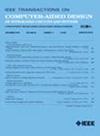PDNNet:基于pdn感知的GNN-CNN异构网络动态红外下降预测
IF 2.9
3区 计算机科学
Q2 COMPUTER SCIENCE, HARDWARE & ARCHITECTURE
IEEE Transactions on Computer-Aided Design of Integrated Circuits and Systems
Pub Date : 2024-11-29
DOI:10.1109/TCAD.2024.3509796
引用次数: 0
摘要
电力输送网络(PDN)上的红外降与PDN的配置和小区电流消耗密切相关。随着集成电路(IC)设计的不断扩大,动态红外跌落模拟在计算上变得难以承受,基于机器学习的红外跌落预测已经成为一种有前途的解决方案。虽然已有研究将基于卷积神经网络(CNN)的方法应用于红外下降预测任务,但忽略PDN配置的缺点是不可忽视的。在本文中,我们不仅考虑如何正确地表示细胞- pdn关系,而且考虑如何在特征聚合过程中根据其物理性质对IR下降进行建模。因此,我们提出了一种新的图结构PDNGraph来统一PDN结构和细粒度cell-PDN关系的表示。我们进一步提出了一种双分支异构网络PDNNet,它包含两个并行的GNN-CNN分支,以便在学习过程中更好地捕获上述特征。提出了几个关键的设计,使动态红外落差预测非常有效和可解释。我们首次将图结构应用于基于深度学习的动态红外落差预测方法。实验表明,PDNNet优于目前最先进的基于cnn的方法,与商业工具相比,速度提高了545倍,证明了我们方法的优越性。本文章由计算机程序翻译,如有差异,请以英文原文为准。
PDNNet: PDN-Aware GNN-CNN Heterogeneous Network for Dynamic IR Drop Prediction
IR drop on the power delivery network (PDN) is closely related to PDN’s configuration and cell current consumption. As the integrated circuit (IC) design is growing larger, dynamic IR drop simulation becomes computationally unaffordable and machine learning-based IR drop prediction has been explored as a promising solution. Although convolutional neural network (CNN)-based methods have been adapted to IR drop prediction task in several works, the shortcomings of overlooking PDN configuration is non-negligible. In this article, we consider not only how to properly represent cell-PDN relation, but also how to model IR drop following its physical nature in the feature aggregation procedure. Thus, we propose a novel graph structure, PDNGraph, to unify the representations of the PDN structure and the fine-grained cell-PDN relation. We further propose a dual-branch heterogeneous network, PDNNet, incorporating two parallel GNN-CNN branches to favorably capture the above features during the learning process. Several key designs are presented to make the dynamic IR drop prediction highly effective and interpretable. We are the first work to apply graph structure to deep-learning-based dynamic IR drop prediction method. Experiments show that PDNNet outperforms the state-of-the-art CNN-based methods and achieves $545\times $ speedup compared to the commercial tool, which demonstrates the superiority of our method.
求助全文
通过发布文献求助,成功后即可免费获取论文全文。
去求助
来源期刊
CiteScore
5.60
自引率
13.80%
发文量
500
审稿时长
7 months
期刊介绍:
The purpose of this Transactions is to publish papers of interest to individuals in the area of computer-aided design of integrated circuits and systems composed of analog, digital, mixed-signal, optical, or microwave components. The aids include methods, models, algorithms, and man-machine interfaces for system-level, physical and logical design including: planning, synthesis, partitioning, modeling, simulation, layout, verification, testing, hardware-software co-design and documentation of integrated circuit and system designs of all complexities. Design tools and techniques for evaluating and designing integrated circuits and systems for metrics such as performance, power, reliability, testability, and security are a focus.

 求助内容:
求助内容: 应助结果提醒方式:
应助结果提醒方式:


